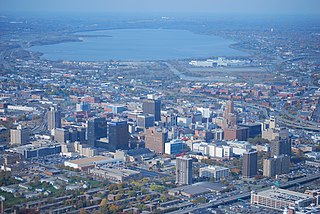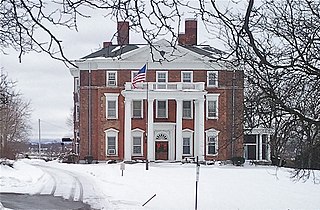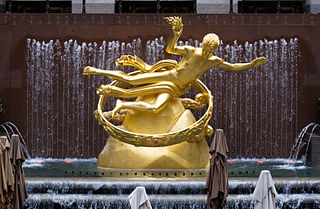
Utica is a city in the Mohawk Valley and the county seat of Oneida County, New York, United States. The tenth-most-populous city in New York State, its population was 65,283 in the 2020 U.S. Census. Located on the Mohawk River at the foot of the Adirondack Mountains, it is approximately 95 miles west-northwest of Albany, 55 mi (89 km) east of Syracuse and 240 mi (386 km) northwest of New York City. Utica and the nearby city of Rome anchor the Utica–Rome Metropolitan Statistical Area comprising all of Oneida and Herkimer Counties.

Saranac Lake is a village in the state of New York, United States. As of the 2010 census, the population was 5,406. The village is named after Upper, Middle and Lower Saranac lakes, which are nearby.

Downtown Syracuse is the economic center of Syracuse, New York, and Central New York, employing over 30,000 people, and housing over 4,300.

United Office Building, now known as the Giacomo, is a historic Mayan Revival, a subset of art deco, skyscraper in Niagara Falls, New York, US.

Electric Tower is a historic office building and skyscraper located at the corner of Washington and Genesee Streets in Buffalo. It is the seventh tallest building in Buffalo. It stands 294 feet (89.6 m) and 14 stories tall and is in the Beaux-Arts Classical Revival style. It was designed by James A. Johnson and built in 1912. The tower was based upon an earlier Electric Tower constructed for the 1901 Pan-American Exposition; as with most of the buildings constructed for that event, the original was only temporary and demolished shortly after the fair ended. Additions were made in 1923 and 1928. The white terra-cotta clad was originally built as the Niagara Mohawk Building and features an octagonal tower which steps back three times to terminate in a large lantern. It is also known as Iskalo Electric Tower, for the real estate development company that owns the building.

James Addison Johnson was an American architect known for his design of various architectural landmarks in Buffalo, New York, and his use of decorative work that many consider a foreshadowing of art deco design.
Duane Lyman (1886–1966) was an architect based in Buffalo, New York, known for his prolific career which included 100 school buildings, many churches, and numerous large homes both in the city and suburban communities. At the time of his death, Lyman was referred to as the "dean of Western New York Architecture."

The former Saratoga Gas, Electric Light and Power Company Complex is located near the northern boundary of Saratoga Springs, New York, United States. It is a seven-acre parcel with two brick buildings on it. In the 1880s it became the thriving resort city's first power station.

The Architecture of Buffalo, New York, particularly the buildings constructed between the American Civil War and the Great Depression, is said to have created a new, distinctly American form of architecture and to have influenced design throughout the world.

South Salina Street Downtown Historic District is a historic district representing what was the commercial core of in Syracuse, New York from the mid-nineteenth century to the mid-twentieth century. It was listed on the National Register of Historic Places on October 16, 2009. The vacancy rate in the district is high, and some buildings need extensive rehabilitation. Recent revitalization plans served as impetus for seeking listing on the National Register of Historic Places.

New York Central Railroad Passenger Station is a former railroad station in Syracuse, New York. It was listed on the National Register of Historic Places on September 11, 2009. The former station currently is the home to Spectrum's Central New York operations.

The Barnes-Hiscock House is a historic building located at 930 James Street in Syracuse, New York. It was listed on the National Register of Historic Places on July 30, 2010.

Mechanicville Hydroelectric Plant is a 18.3-acre (7.4 ha) national historic district located at Mechanicville in Saratoga County, New York. The listing included one contributing building and three contributing structures. The district dates to 1897 and includes notable Queen Anne architecture.

The Hebrew Tabernacle of Washington Heights is an historic domed Art Deco style building and Reform synagogue. It is located at 551 Fort Washington Avenue, on the corner of 185th Street, in the Washington Heights neighborhood of Manhattan in New York City.
Niagara Mohawk Power Corporation was a New York State utility company, which was acquired in 2000 by National Grid plc. The Niagara Mohawk Power Corporation designation was retired, using variations of NationalGridUS, though its official designation on annual reports is still Niagara Mohawk Power Corporation.
Esenwein & Johnnson was an architectural firm of Buffalo, New York.

American Radiator Company Factory Complex, also known as the Pierce Plant, American Radiator & Standard Sanitary Stamping Plant, Institute of Thermal Research, Equipment Plant, and Malleable Foundry, is a historic factory complex located in Buffalo, Erie County, New York. The complex was built between 1891 and 1959, originally by Pierce Steam Heating Company and expanded by its successor the American Radiator Company. It consists of three distinct sections: 1.) the Institute of Thermal Research, 2.) the Equipment Plant, and 3.) the Malleable Foundry. American Radiator amalgamated with Standard Sanitary Manufacturing Company in 1929 to form the American Radiator and Standard Sanitary Corporaton, later becoming American Standard in 1967. The Institute of Thermal Research section is an administrative / laboratory building that is a two-story brick building with a stone foundation and an "E"-shaped plan. The original section includes Prairie School design elements. Additions to the factory buildings were made in 1906 and 1910 by prominent Buffalo architect Edward Brodhead Green.

Ellenville Downtown Historic District is a national historic district located at Ellenville, Ulster County, New York. It encompasses 52 contributing buildings and 3 contributing sites in the central business district of Ellenville. It developed after 1823, with the construction of the Delaware and Hudson Canal, and includes notable examples of Greek Revival, Italianate, Late Victorian, and Art Deco architecture. Located in the district are the separately listed Christ Lutheran Church and Parsonage, George and John R. Hunt Memorial Building, and United States Post Office. Other notable contributing resources include the Ellenville United Methodist Church (1858), First National Bank Building (1868), Wawarsing Town Hall (1895), Norbury Hall, Scoresby Hook and Ladder, Cohen's Bakery, Ellenville Electric Co. Building (1914), Home National Bank (1928), H. Rosenstock and Sons clothing factory, the Miller Building, and the Village Motel.

The Art Deco style, which originated in France just before World War I, had an important impact on architecture and design in the United States in the 1920s and 1930s. The most famous examples are the skyscrapers of New York City including the Empire State Building, Chrysler Building, and Rockefeller Center. It combined modern aesthetics, fine craftsmanship and expensive materials, and became the symbol of luxury and modernity. While rarely used in residences, it was frequently used for office buildings, government buildings, train stations, movie theaters, diners and department stores. It also was frequently used in furniture, and in the design of automobiles, ocean liners, and everyday objects such as toasters and radio sets. In the late 1930s, during the Great Depression, it featured prominently in the architecture of the immense public works projects sponsored by the Works Progress Administration and the Public Works Administration, such as the Golden Gate Bridge and Hoover Dam. The style competed throughout the period with the modernist architecture, and came to an abrupt end in 1939 with the beginning of World War II. The style was rediscovered in the 1960s, and many of the original buildings have been restored and are now historical landmarks.

The Ogden/Weber Municipal Building, at 2541 Washington Blvd. in Ogden, Utah, was built in 1938–1940. It was listed on the National Register of Historic Places in 1983.




















